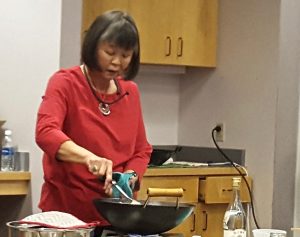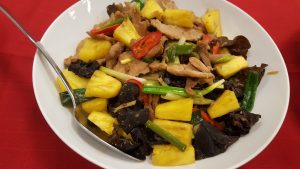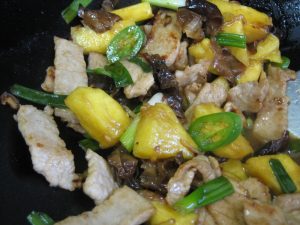Thanks to everyone who braved the rain Monday night and showed up for my event at the Menlo Park Library. We had a good turnout. Everyone seemed to enjoy the presentation. It was especially rewarding for me to meet some fellow Hakka in the audience.
I gave a short introduction on the Hakka history and cuisine, followed by slides of traditions and foods for Chinese New Year. I ended by cooking three recipes from The Hakka Cookbook that might fit into a New Year dinner.
Here is one of the recipes I demonstrated. It is in The Hakka Cookbook but I increased the quantities slightly here so there would be more for tasting. This recipe was featured in the New York Times Magazine several years ago.
Stir-fried Pork and Pineapple (The Hakka Cookbook, p. 92)
This stir-fry from Taiwan is reminiscent of a lighter and fresher version of sweet and sour pork. Auspicious ingredients include crunchy black fungus that represents longevity. Pineapple symbolizes wealth, luck, excellent fortune, and luck in gambling. Pork offers strength, wealth, and abundant blessings.
Makes 3 servings as a main dish or 5 to 6 servings as part of a multicourse meal
Pork
12 ounces boneless pork shoulder, leg, or loin, trimmed of fat
1 tablespoon soy sauce
1 1/2 teaspoons vegetable oil
1 1/2 teaspoons cornstarch
Sauce
3 tablespoons rice vinegar
1 1/2 tablespoons sugar
1 1/2 tablespoons soy sauce
3/4 teaspoon salt
Stir-fry
12 pieces dried black fungus, such as cloud ears, each about 1 inch wide
5 green onions, including green tops, ends trimmed
2 tablespoons vegetable oil
3 tablespoons thinly slivered fresh ginger
12 ounces fresh pineapple, cut into 3/4-inch chunks (about 1 1/2 cups)
6 to 10 thin rings fresh chile (preferably red) such as jalapeno or Fresno (remove seeds, if you prefer less spicy heat)
1. For the pork: Thinly slice pork into strips about 2 inches long and 1 inch wide. In a small bowl, mix the pork with the soy sauce, oil, and cornstarch.
2. For the sauce: In a small bowl, mix the vinegar, sugar, soy sauce, and salt.
3. For the stir-fry: Rinse the fungus. Soak the fungus in hot water until soft, 5 to 15 minutes, drain. Pinch out and discard any hard knobby centers. Cut the fungus into 1-inch pieces. Cut the green onions into 2-inch lengths. Cut thick ends in half lengthwise.
4. Set a 14-inch wok or 12-inch frying pan over high heat. When the pan is hot, after about 1 minute. Add the oil and rotate the pan to spread. Add the ginger and pork; stir-fry until meat is lightly browned, about 2 minutes. Add the pineapple, black fungus, sauce mixture, green onions, and chile. Stir-fry until the pineapple is hot, 1 to 2 minutes. Transfer to serving dish.





